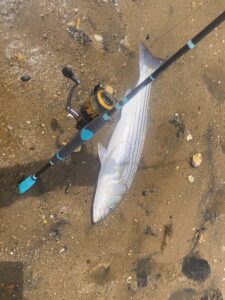A year off from graduate school in 1972 gave me the chance to fulfill my dream of being on Cape Cod all year round. I finagled free winter digs in a house overlooking North Pamet Road in Truro in return for some carpentry and home improvement projects and teamed up with a pal to do some house painting to pay for such essentials as groceries, fishing line, and surf wax.
One clear October morning, we showed up on Great Hollow Road in Truro at our first job, as promised, at 7 a.m. The client was an elderly woman who lived in a vintage Cape cottage that was in dire need of trim work. I knocked on her door, which opened immediately. From the stern, quizzical look on her face I could tell we had already done something wrong.
“The stripers are running!” she shouted in a half-angry, half-confused tone, all the while sweeping her arm towards the bay. “What are you doing here when there are fish to catch?”
Her disdain was a revelation, and as we packed our ladders and tools and headed to the beach, I realized her reaction was a taste of a bygone era when fishing was not simply a matter of recreation but something essential, at the very core of what it meant to be a Cape Codder.

I had learned a little about the Cape’s old fishing culture as a teenager, when Jack Papetsas, a summer neighbor in Provincetown’s West End, began taking me dragger fishing on the Peter & Linda —one of the town’s highliners at the time. Jack was a jovial character who had recognized our common love for fishing and the sea.
Those days began at 2 a.m. I’d bike to the Portuguese Bakery to pick up a bag of steaming fresh-baked loaves, which we would wolf down on our way to the fishing grounds. I loved listening to the older crew members, who unraveled many fishing mysteries for me, including why many draggermen never learned to swim. “If I fall overboard in the winter, what good is it to know how to swim? I’d rather drown quickly,” a grizzled crewman explained. I was paid in dragged-up lobsters.
After a few hours of fishing that October morning, I returned to the job on Great Hollow to start painting, this time bearing a nice fat schoolie as a gift. I never did ask my client how she knew that the fish were running. But it was fall, when fish start to feed actively on the surface, and I assumed everyone knew the fish were on the shore.
Early in the striper season, fish often feed quietly in the shallows, looking for crabs, mummichogs, and other bottom-dwelling delicacies. If nothing is actively showing on the surface, it’s best to fish soft-tail jigs off the bottom. On still days, watch for any “nervous water” — little ripples and swirls that indicate a school of stripers underneath. Terns, always the best fish-spotters, haven’t shown up, but ospreys are starting to nest. When you see them with a fish in their talons you can bet river herring or menhaden are out and about.
Occasionally the back shore offers great early fishing, but the majority of the early spring schoolie run takes place in the Cape’s mostly accessible estuaries. Some of the better early locations include Middle Meadows in Eastham, Pleasant Bay in Orleans, Lieutenant Island and the Herring River in Wellfleet, and Truro’s Pamet Harbor.
The best estuary fishing is on low outgoing tides as the foraging fish move out of the shallow creeks and bays. I often start fishing around the middle of the outgoing tide. Incoming tides can also be productive. Where you fish will also depend on wind speed and direction. The fishing is a lot more comfortable, if not better, when the wind is at your back allowing much longer casts.
Any activity on top of the water needs to be acknowledged with a popper or surface-swimming lure. But often the best lure is a silicon soft-tail one. Don’t spend a lot of time or money buying the range of weighted lead jigs and colored silicon tails. The best sizes for the first six weeks of the striper run are half-ounce or three-quarter-ounce jigs (depending on your rod and line strength). I’ve found that the best color for tails by far is white. These sell out quickly, so if white isn’t available try a light blue or green tail with little dark spots — these resemble the stripers’ favorite snack, baby menhaden, also known as peanut bunker.
Al Gag makes great soft-tail jigs, but after disputes with retailers during the Covid supply chain crisis it’s best to order from their website. Wherever you get them, please pinch the barbs before casting. The first fish are the smallest of the year, and it’s important to safely release all undersize fish so they can reach keeper size.



